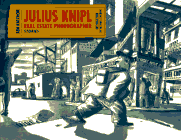Julius Knipl, Real Estate Photographer
Ben Katchor, writer/artist
Little, Brown & Company, 1996
106 pages
$12.95
Glimpses of lost New York City are both thrilling and sad. The times I’ve encountered them–the absurdly ornate urinals in the Marvel Comics lobby a few office buildings ago, an elaborate and unused pneumatic tube system in an office I once visited while working as a production assistant on a short-lived David Milch cop show, tiny mom and pop repair shops with Eastern European names on small streets buried beneath bridges or behind the entrances of tunnels–have left me wondering how wonderful these things must have seemed in their heyday, and how futile the enterprises must seem now.
What a stroke of genius, then, to create an entire comic strip about lost New York–the lost past of anyplace really; no need to be chauvinistic about it. Double-genius to make it about an imaginary lost New York–eerily, surreally plausible business that never existed but might have. Licensed expectorators with the proper permits to spit in the faces of whoever those who hired them designate. A tripwire system running from the graveyard to the apartments of the bereaved, to alert them if their loved ones have risen from the dead. A bus line-slash-roving theater that strategically places actors along its route for the viewing enjoyment of its riders. A system of cattle ranch-style marks on the collars of laundered work uniforms to stake out the turf of rival commercial laundries. The niche businesses that Katchor’s everyman protagonist Julius Knipl encounters on his perambulations (that’s really the best word for his long-strided journeys through the city) fit neatly in the cracks of our waking life amid the uncountable multitude of sights and sounds in the city, to the point where it’s easy to convince ourselves we really have seen the brand of the Mansoyl Towel and Apron Supply Co. on the sleeve of the busboy at the restaurant where we spent our lunchbreak.
What I’m trying to get at is how well Katchor conjures up the repleteness of the city. In a town conjured from the accrued history of millions of people over decades of time, there is, almost literally, something for everyone. A big part of this is the way he frames his panels, using odd angles halfway between a normal stage view and the cantered frames of Expressionist film, disorienting us, showing us not just businessmen and their stock in trade but suggesting their showrooms’ dusty corners and the chipped paint of their ceilings, the airshafts of their tenements and the shadows cast by their radiators as the afternoon light strikes them through a lead-painted windowframe. It’s a tactile environment, one you can dive right into with no sense that beyond the panel border, there’s a calm cool nothingness.
But the best way to get across what I’m saying, I think, is by pointing out one of the strip’s recurring devices: Experts who can interpret minute variations of everyday human behavior to further their business ends. There’s one who can predict the turns of the economy based on the frequency and severity of brassiere-strap slippage. Another has set up a rooftop observatory to pinpoint the degree to which everyone limps. In the collection’s climactic, longer piece, “The Evening Combinator,” a newspaper publishes accounts of people’s dreams, the details of which are gleaned from studying the grooves in their mattresses, the cadence of their snoring, how their eyes look as they wake up.
What comes across from these strips is the sort of dizzying impression that the city is big enough and full enough for someone to have devoted a lifetime to the refined research of this sort of arcana, and that there’s enough demand for it to make a living. For me it triggers memories of the first time I realized that everything that gets done on planet Earth gets done because someone does it–a trip to Disney World, when it occurred to me that it’s someone’s job to clean one specific bathroom at one specific ride in one specific section of one specific park…and so on and so on and so on…To conceive of a world, an environment large enough to accommodate the minutiae we see in Julius Knipl is exhilarating, and a little frightening, like looking at an ocean made of rumpled men in shirtsleeves, men offering a handshake, men you can do business with.
Tags: comics, comics reviews, Comics Time, reviews


One Response to Comics Time: Julius Knipl, Real Estate Photographer